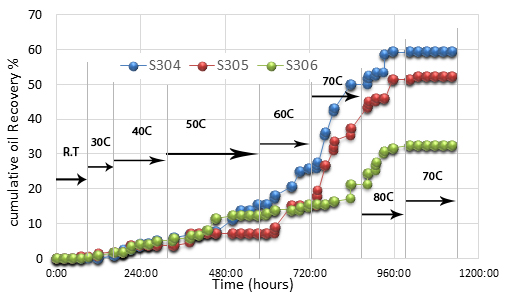Comparative Study of Using Sea-Water for Enhanced Oil Recovery in Carbonate and Sandstone Reservoirs: Effects of Temperature and Aging Time on Oil Recovery
Abstract
Oil recovery process is an essential element in the oil industry, in this study, a laboratory study to investigate the effect of temperature and aging time on oil recovery and understand some of the mechanisms of seawater in the injection process. In order to do that, the sandstone and carbonate cores were placed in the oven in brine to simulate realistic reservoir conditions. Then, they were aged in crude oil in the oven. After that, they were put in the seawater to recover, and this test is called a spontaneous imbibition test. The spontaneous imbibition test in this study was performed at room temperature to oven temperature 80 oC with different sandstone and carbonate rock with aging time of 1126 hours. The result shows that the impact of seawater on oil recovery in sandstone is higher than carbonate. At higher temperature, the oil recovery is more moderate than low temperature. Likewise, as the aging time increase for both sandstone and carbonate rocks the oil recovery increase.
Full text article
References
Anderson, W., 1987b, Wettability Literature Survey Part 5: The Effects of Wettability on Relative Permeability: SPE-16323-PA.
Anderson, W. G., 1987c, Wettability Literature Survey – Part6: Effect of Wettability on Water-flooding, Volume 39, SPE-16471-PA, p. 18.
Anderson, W. G., 1986a, Wettability Literature Survey- Part 1: Rock/Oil/Brine Interactions and the Effects of Core Handling on Wettability: Journal of Petroleum Technology, v. 38, no. 10, p. 1125-1144.
Anderson, W. G., 1986b, Wettability Literature Survey – Part2: Wettability Measurements: Journal of petroleum technology, v. 38, no. 12, p. 1246-1262.
Anderson, W. G., 1987a, Wettability Literature Survey – Part4: Effect of Wettability on Capillary Pressure: Journal of petroleum technology, v. 39, no. 10, p. 1283-1293.
Bavière, M., 1991, Basic concepts in enhanced oil recovery processes, Springer.
Castor, T., Somerton, W., and Kelly, J., 1981, Recovery mechanisms of alkaline flooding, Surface phenomena in enhanced oil recovery, Springer, p. 249-291.
Cuiec, L., Restoration of the natural state of core samples, in Proceedings Fall Meeting of the Society of Petroleum Engineers of AIME1975, Society of Petroleum Engineers.
Culec, L., 1977, Study of problems related to the restoration of the natural state of core samples: Journal of Canadian Petroleum Technology, v. 16, no. 04.
Farouq-Ali, S., and Stahl, C., 1970, Increased oil recovery by improved waterflooding: Earth Miner. Sci.;(United States), v. 39, no. 4.
Mungan, N., 1972, Relative permeability measurements using reservoir fluids: Society of Petroleum Engineers Journal, v. 12, no. 05, p. 398-402.
Naser, M. A., 2014, A Laboratory Investigation of the Effects of Temperature, Hardness, Surfactants, and Alkaline on Oil Recovery from Carbonate Reservoirs Using Spontaneous Imbibition Tests: First International Conference on Science and Technology, Tobruk University p. 15.
Naser, M. A., Bae, W., Permad, A. K., and Gunadi, T. A., A Success Story in a Plan of Development Study: Increasing Recovery of Sandstone Reservoir by Water Injection in Indonesia, South Korea, 2013, Sejong University
Schumacher, M., 1978, Enhanced oil recovery. Secondary and tertiary methods.
Tang, G.-Q., and Morrow, N. R., 1999a, Influence of brine composition and fines migration on crude oil/brine/rock interactions and oil recovery: Journal of Petroleum Science and Engineering, v. 24, no. 2-4, p. 99-111.
Tang, G., and Morrow, N., 1999b, Oil Recovery by Water flooding and Imbibition–Invading Brine Cation Valency and Salinity, paper: SCA-9911.
Tang, G., and Morrow, N. R., 2002, Injection of dilute brine and crude oil/brine/rock interactions: Washington DC American Geophysical Union Geophysical Monograph Series, v. 129, p. 171-179.
Wendell, D., Anderson, W., and Meyers, J., 1987, Restored-State Core Analysis for the Hutton Reservoir: SPE Formation Evaluation, v. 2, no. 04, p. 509-517.
Wissmann, W., Displacement tests with porous rock samples under reservoir conditions, in Proceedings 6th World Petroleum Congress, Frankfurt am Main, Germany, 1963 1963, World Petroleum Congress, p. 16.
Zhang, Y., and Morrow, N. R., Comparison of secondary and tertiary recovery with change in injection brine composition for crude-oil/sandstone combinations, in Proceedings SPE/DOE Symposium on Improved Oil Recovery2006, Society of Petroleum Engineers.
Authors
This is an open access journal which means that all content is freely available without charge to the user or his/her institution. The copyright in the text of individual articles (including research articles, opinion articles, and abstracts) is the property of their respective authors, subject to a Creative Commons CC-BY-SA licence granted to all others. JEEE allows the author(s) to hold the copyright without restrictions and allows the author to retain publishing rights without restrictions.




